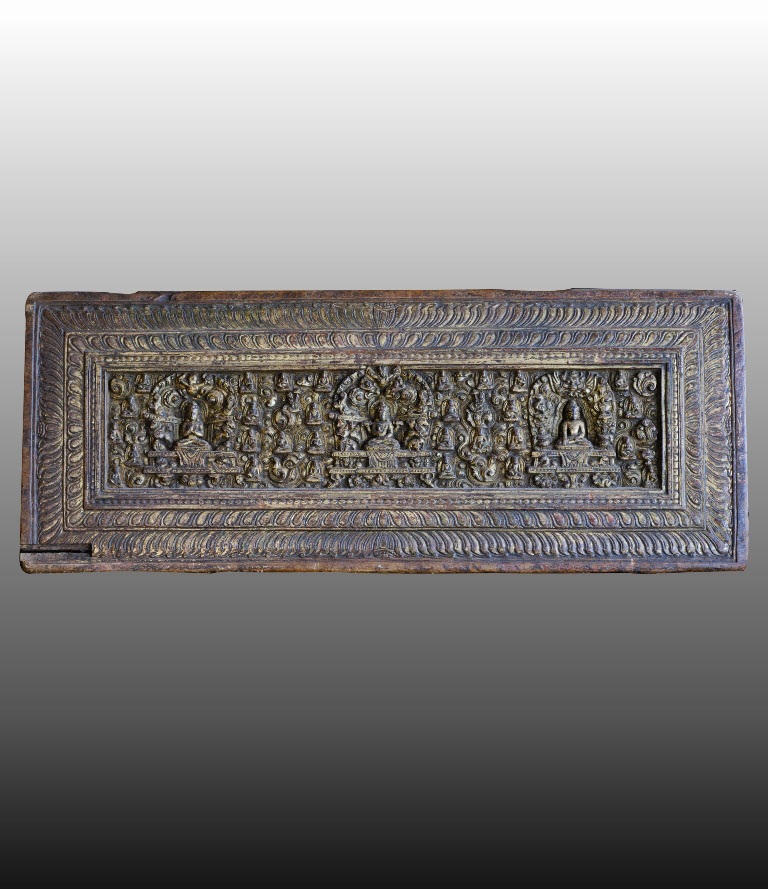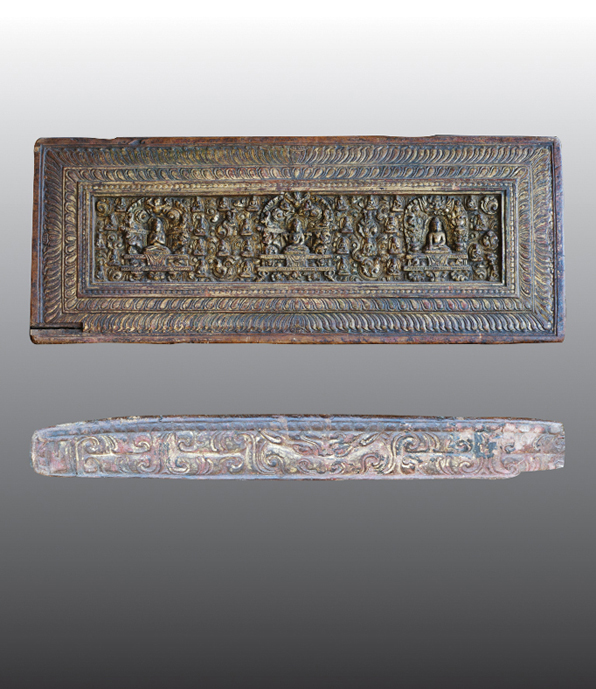|
|
«« go back
Book cover
Tibet - Wood - Width 73 cm - height 29 cm - 15th century
The format of Tibetan books, rectangular and rather long, conforms to the Indian model, which follows the natural shape of the palm leaves used as pages. However, following Chinese use, Tibetans chose paper, which is more resistant and less fragile than palm leaves, to write or print their texts. This feature brings to light the insight of Tibetans, who did not limit themselves simply to making the most interesting aspects of cultures bordering their own, but also knew how to merge them with their own, adapt- ing them to their needs whilst still maintaining their characteristics.
Tibetans preserved their books on large bookshelves, generally housed inside temples. Wooden covers of Tibetan books such as this one often feature valuable carvings and sometimes elaborate pictures, which reveal the special veneration they have for their sacred texts (1). The thickness of the wood, whose weight is necessary to hold the sheets pressed down together leads to a frequent recourse to engraving. The decoration is frequently embellished with gilding as a decorative technique for the upper face of the book. These covers are often true works of art.
Generally, a frame engraved with motifs representing rows of pearls, lotus petals or intricate plant motifs is added to the central decorations of the cover. These elements are not simply decorative, but also limit a sacred space and are hence a reminder that the central image of the cover, just like the content of the book, belongs to the sphere of the divine. At times, the internal space may feature symbolic elements, but the most valuable exemplars are those which enclose images of deities or masters. These are produced by means of deep engravings which create a high relief effect. In Tibetan covers, decorations carry no narrative function, although this does sometimes occur on Nepalese covers (see no. 8), as the only aim of the images of the deities represented is to protect the writ- ings contained in the book and make them sacred. Dating a wooden cover basing oneself simply on the style in which it has been engraved, should the book itself not provide a term for the dating, may prove highly complex. This is because books, as receptacles of the doctrine of Buddha, belong to a particularly conservative area of artistic production characterized by the persistence of various stylistic solutions which asserted themselves over the years. This wooden cover was used to protect a version of the Prajnâpâramitâ, the “Perfection of Wisdom”, a collection of some of the most important texts ever to be produced within theGreat Vehicle (Mahâyâna) tradition. The letter ka, the first in the Tibetan alphabet, engraved in the side margin of the cover, indicates that it is the first volume in a series. In the Himalayan and Tibetan worlds, these texts were translated at different times, continuously copied and widely appreciated as a gift, also because of the magical powers attributed to them.
The “Perfection of Wisdom” is also represented through a divine manifestation (see card no. 8), in the form of the goddess Prajnâpâramitâ. Represented with six arms, she is set in the centre of the cover presented here and depicted with two of her many attributes: the vajra and the book. Tied to the Family of Cosmic Buddha Akshobhya or of Ratnasambhava, over the years she was assimilated with the goddess Târâ, joining the Family of the Bodhisattva Avalokiteshvara presided over by Buddha Amitâbha (2).The Tibetans often call her by the epithet “Great Mother” (Yum-chen-mo).
Maitreya seems to be depicted to Prajnâpâramitâ’s proper right, making the gesture of argumentation, whilst the historical Buddha Shâkyamuni is to her left. The three figures are surrounded by an elaborate prabhâ produced in a typically Newar style which was very common in Tibet, too (see no.. 7). A multitude of minor figures, Bodhisatt- vas and masters of the doctrine surround the main deity. The empty spaces between the small figures have been filled with shoots and leaves, denoting the sense of horror vacui which is so typical to Indo-Tibetan art. (1) Cf. Franco Ricca, Copertine lignee dei libri tibetani, in Sonia Bazzeato Deotto (ed.), Tibet. Arte e spiritualità. Un contributo alla storia dell’uomo, Skira, Milano 1999, pp. 138-139. (2) Erberto Lo Bue, Immagini divine e spazi sacri, in Erberto Lo Bue - Chiara Bellini, Arte del Ladak. Tesori di arte buddhista nel Tibet indiano dall’XI al XXI secolo, Jaca Book, Milano 2011 (for- thcoming).
|

